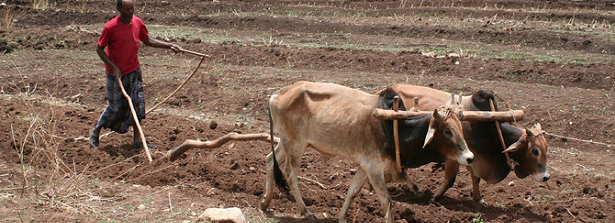Land Preparation

- Emmer Wheat (Triticum dicoccum schub L.) : This type was reported to be grown in south i.e. Maharashtra, Tamil Nadu and Karnataka. This type is believed to be developed from T. diccoides koru., a wild form. It is also grown in Spain, Italy, Germany and Russia.
- Macroni Wheat ( T.durum Desf.) : The durum or macroni wheat, cultivation in India, is considered to be very old. It is a best wheat for drought conditions or under restricted irrigated conditions of Punjab, M.P., Karnataka, Tamil Nadu, Gujarat, West Bengal and H.P. It is used for semolina (suji) preparation.
- Common Bread Wheat ( T. vulgare Host) : It is a typical wheat of alluvial soils of Indo-Gangetic plains i.e.Punjab, Uttar Pradesh, Bihar and parts of Rajasthan. The bulk of the Indian crop, therefore, consists of this type.
- Indian Dwarf Wheat (T.spherococcum Mihi.) : This belongs to the club wheat of western countries. This is found in limited areas of M.P., U.P., of India and in Pakistan. These are characterised by very short and compact heads having a shorter grains.
- Triticum aestivum : This is the type presently grown in India in almost all the wheat growing zones. It is used mainly for bread purpose.
Sowing Process
- Sowing time: Based on above temperature requirement it has been found that for indigenous wheat last week of October, for long duration dwarf varieties like Kalyansona, Arjun, etc. first fortnight of November and for short duration dwarf wheats like Sonalika, Raj 821 etc. second fortnight is the best sowing time. Under exceptionally late sown condition it may be delayed to latest by 1st week of December beyond which if area is very small transplanting may be practiced.
- Seed rate: Generally, a seed rate of 100 kg/ha has been found to be sufficient for most of the varieties like Kalyan Sona, Arjun, Janak, etc.which have moderate tillering and medium sized grains. But a higher seed rate of 125 kg/ha is desirable for late sown wheat and normal sown for varieties like Sonalika, Raj 821 etc. which have bold grains and shy tillering habits.
- Spacing: : For irrigated, timely sown wheat, a row spacing of 15 to 22.5 cm is followed, but 22.5 cm between the rows is considered to be the optimum spacing. Under irrigated late-sown conditions, a row spacing of 15-18 cm is the optimum. For dwarf wheats, the planting depth should be between 5 and 6 cm. Planting beyond this depth results in a poor stand. In the case of conventional tall varieties, the depth of sowing may be 8 or 9 cm.
- Seed treatment: The seed of loose smut-susceptible varieties should be given solar or hot-water treatment. If the wheat seed is used only for sowing, and not for human consumption or for feeding cattle, it can be treated with Vitavax.
Land Preparation
The wheat crop requires a well-pulverized but compact seed bed for good and uniform germination. Three or four ploughings in the summer, repeated harrowing in the rainy season, followed by three or four cultivations and planking immediately before sowing produce a good, firm seed bed for the dry crop on alluvial soils. For the irrigated crop, the land is given a pre-sowing irrigation (palewa or raund) and the number of ploughings is reduced. Where white ants or other pests are a problem, Aldrin 5% or BHC 10% dust at the rate of 25 kg/ha should be applied to the soil after the last ploughing or before planking.
Soil and Climate
Wheat plants are sensitive to very cold or frost injury at any stage of growth particularly at reproductive growth if temperature is below 150